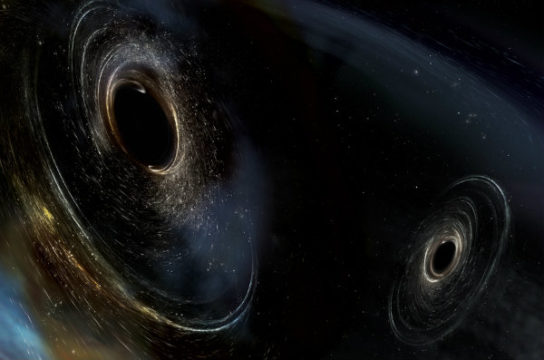For the first time, the LIGO and Virgo gravitational-wave detectors have “heard” gravitational waves from an unequal pair of black holes.
Scientists working with the LIGO and Virgo gravitational-wave observatories have detected an oddball event: the merger of two black holes of notably different sizes. All 10 black hole mergers detected in the first two observing runs had binary components with similar masses. But the new event, called GW190412, involved objects of about 8 and 30 solar masses, respectively. This asymmetry made the “hum” of overtones in the gravitational waves clear for the first time, enabling researchers to narrow in on the binary’s properties.

LIGO / Caltech / MIT / Aurore Simonnet (Sonoma State)
The merger occurred roughly 2 billion light-years away, tilted from our line of sight by about 45°. Before the two black holes came together, the larger one was spinning fairly slowly — roughly 40% the maximum permitted by gravity. This is the first time researchers have been able to confidently measure the spin of a black hole about to merge, collaboration members announced April 18th at the American Physical Society’s virtual meeting.
Previous work pointed to spins in two other merging systems, but later analysis suggests those might have been overestimates. The data for the previous 10 systems don't rule out zero spin for the merging black holes. (LIGO scientists also haven’t yet incorporated additional candidates from independent analyses.)
The gravitational-wave observatories detected the signal, designated GW190412, at the start of the third observing run, which happened in two segments spanning April 1 to October 1, 2019, and November 1, 2019, to March 27, 2020. The third observing run would have run through April, but was suspended due to the COVID-19 pandemic. So far the collaboration has 56 confirmed candidates from this run, two of which now have published analyses. Scientists are actively analyzing the rest.
Finding that one of GW190412’s black holes was some three times more massive than the other is intriguing, because many scenarios for how these binaries form favor making pairs of similarly sized objects. But scientists won’t know what the implications are until they have more detections.
Find more information on GW190412's unequal match-up at the press release from the Max Planck Institute for Gravitational Physics.
 2
2









Comments
Donald W.-Bennett
April 25, 2020 at 10:34 am
Fascinating. However, I was unable to find what the size estimate is for the resulting merged black hole. In other words, what was the size of the resulting black hole and how much energy was released in it's formation? The released energy in a black hole merger has always impressed me.
You must be logged in to post a comment.
Kim Burtnyk
April 27, 2020 at 4:03 pm
According to the paper published last week, final combined mass was 37 Solar masses. Progenitors separately totaled 38.1. Thus, mass converted to gravitational-wave energy was approximately 1.1 Solar masses (give or take within the quoted uncertainties).
You must be logged in to post a comment.
You must be logged in to post a comment.